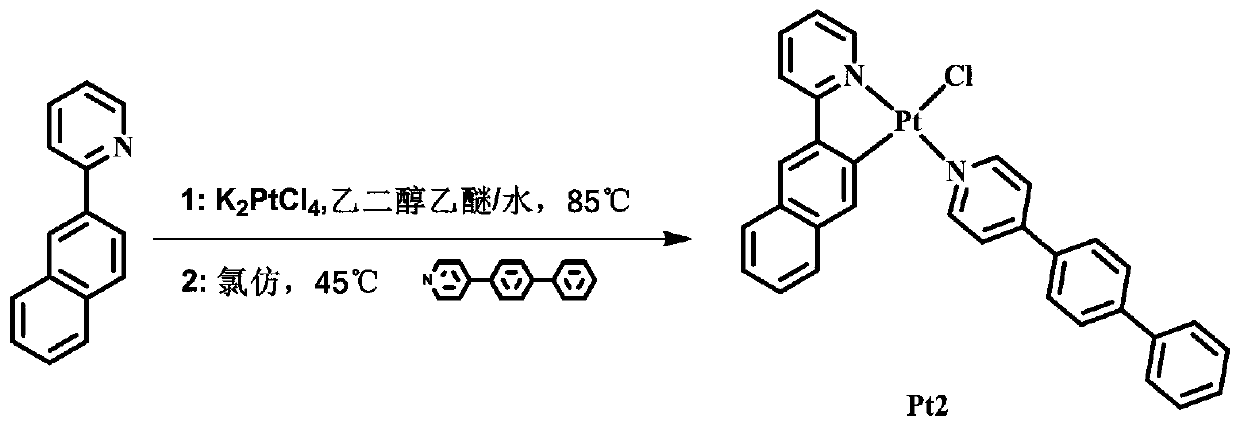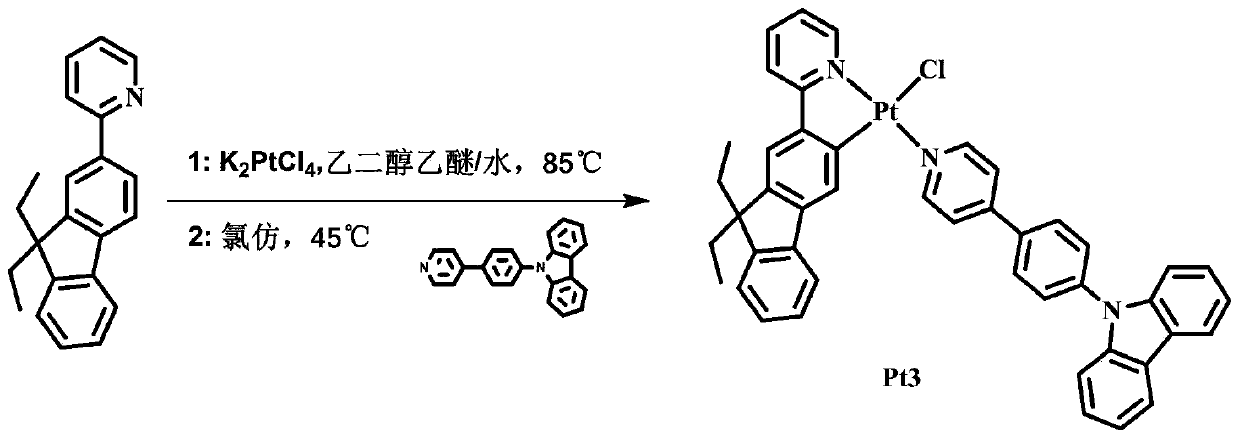Phosphorescence aggregation-induced emission material of platinum (II) complex containing nitrogen monodentate ligand and C^N bidentate ligand
A technology of monodentate ligands and bidentate ligands, applied in the direction of luminescent materials, platinum-group organic compounds, platinum-based organic compounds, etc., can solve problems such as the gap in electroluminescent efficiency and achieve important application value effects
- Summary
- Abstract
- Description
- Claims
- Application Information
AI Technical Summary
Problems solved by technology
Method used
Image
Examples
Embodiment 1
[0024] Phosphorescence aggregation-induced luminescent material Pt1 of the platinum (II) complex of the nitrogen-containing monodentate ligand and the C^N bidentate ligand of the present embodiment, the chemical formula is C 20 h 15 ClN 2 Pt, the molecular structure formula is:
[0025]
[0026] refer to figure 1 , the synthesis steps are as follows:
[0027] The first step: 0.2g organic ligand with 0.39g K 2 PtCl 4 Put it into the reaction container, add 24mL of a mixed solvent of ethylene glycol ether and water in a nitrogen atmosphere, the volume ratio of ethylene glycol ether and water in the mixed solvent is 3:1, heat to 85°C in a nitrogen atmosphere, and stir for 8 hours Cool to room temperature, add 50mL deionized water to the reaction tube to precipitate solids, filter, take the filter cake and dry to obtain the intermediate product;
[0028] The second step: put the intermediate product and 0.07g of pyridine into the reaction tube, add 15mL of chloroform un...
Embodiment 2
[0032] The phosphorescent aggregation-induced luminescent material Pt2 of the platinum (II) complex of nitrogen-containing monodentate ligand and C^N bidentate ligand of the present embodiment, chemical formula is C 32 h 23 ClN 2 Pt, the molecular structure formula is:
[0033]
[0034] refer to figure 2 , the synthesis steps are as follows:
[0035] The first step: 0.2g organic ligand with 0.39g K 2 PtCl 4 Put it into the reaction container, add 24mL of a mixed solvent of ethylene glycol ether and water in a nitrogen atmosphere, the volume ratio of ethylene glycol ether and water in the mixed solvent is 3:1, heat to 85°C in a nitrogen atmosphere, and stir for 8 hours Cool to room temperature, add 50mL deionized water to the reaction tube to precipitate solids, filter, take the filter cake and dry to obtain the intermediate product;
[0036] The second step: the intermediate product and Put 0.2g into the reaction tube, add 20mL chloroform under nitrogen atmospher...
Embodiment 3
[0040]Phosphorescence aggregation-induced luminescent material Pt3 of the platinum (II) complex of nitrogen-containing monodentate ligand and C^N bidentate ligand of the present embodiment, chemical formula is C 45 h 36 ClN 3 Pt, the molecular structure formula is:
[0041]
[0042] refer to image 3 , the synthesis steps are as follows:
[0043] The first step: 0.2g organic ligand with 0.31g K 2 PtCl 4 Put it into the reaction container, add 24mL of a mixed solvent of ethylene glycol ether and water in a nitrogen atmosphere, the volume ratio of ethylene glycol ether and water in the mixed solvent is 3:1, heat to 85°C in a nitrogen atmosphere, and stir for 8 hours Cool to room temperature, add 50mL deionized water to the reaction tube to precipitate solids, filter, take the filter cake and dry to obtain the intermediate product;
[0044] The second step: the intermediate product and Put 0.23g into the reaction tube, add 20mL chloroform under nitrogen atmosphere, h...
PUM
 Login to View More
Login to View More Abstract
Description
Claims
Application Information
 Login to View More
Login to View More - R&D
- Intellectual Property
- Life Sciences
- Materials
- Tech Scout
- Unparalleled Data Quality
- Higher Quality Content
- 60% Fewer Hallucinations
Browse by: Latest US Patents, China's latest patents, Technical Efficacy Thesaurus, Application Domain, Technology Topic, Popular Technical Reports.
© 2025 PatSnap. All rights reserved.Legal|Privacy policy|Modern Slavery Act Transparency Statement|Sitemap|About US| Contact US: help@patsnap.com



